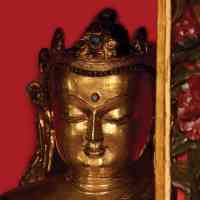
Mindfulness Meditation 02/10/2020 with Tracy Cochran
Theme: Impermanence
About the Mindfulness Meditation Podcast
The Rubin Museum of Art presents a weekly meditation session led by a prominent meditation teacher from the New York area, with each session focusing on a specific work of art. This podcast is recorded in front of a live audience, and includes an opening talk, a 20-minute sitting session, and a closing discussion. The guided meditation begins at 15:09.
If you would like to attend Mindfulness Meditation sessions in person or learn more, please visit our website at RubinMuseum.org/meditation.
This program is supported with thanks to our presenting partners Sharon Salzberg, the Interdependence Project and Parabola Magazine.


Related Artwork

Stupas are made to hold precious relics of the Buddha or other important religious leaders. In India, stupas were originally hemispherical mounds made to hold sacred remains, like those of the historical Buddha Shakyamuni. This is not limited to the mortal remains of a holy person but may also include objects associated with that person, such as clothes, as well as sacred texts, articles of worship, and figures made of clay and the ashes of the deceased (tsa tsa). While a statue or painting of a Buddha represents the divine body of an enlightened being and a book symbolizes divine speech, a stupa represents the mind of supreme spiritual awakening and is thus a symbol of Buddhahood. Stupas can be found in all sizes throughout the Himalayas, marking important locations or boundaries.
About the Speaker

Tracy Cochran is editorial director of Parabola, a quarterly magazine that for forty years has drawn on the world’s cultural and wisdom traditions to explore the questions that all humans share. She has been a student of meditation and spiritual practices for decades and teaches mindfulness meditation and mindful writing at New York Insight Meditation Center and throughout the greater New York area. In addition to Parabola, her writing has appeared in The New York Times, Psychology Today, O Magazine, New York Magazine, the Boston Review, and many other publications and anthologies. For more information please visit tracycochran.org.


